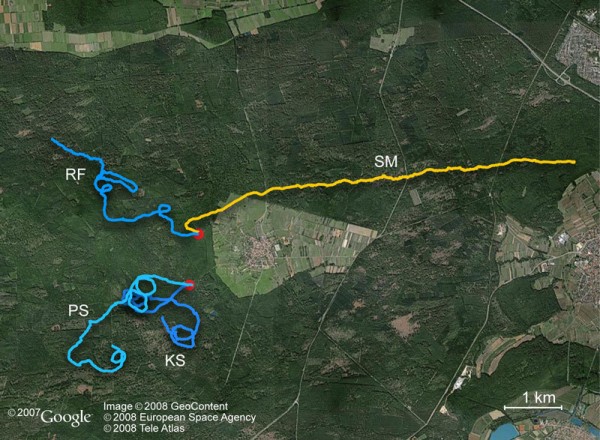It is a common scenario: when we get lost in the wilderness, we wind up walking in circles. Much to our dismay, at some point we’ll revisit our tracks and feel despair that we’ll never make it out of this loop and back to civilization. The German research scientist, Jan Souman’s empirical data confirms that humans have a tendency to not only walk lopsided but to self-navigate within a loop when lost.
Favoring Loops in Poor Visibility

In the study, participants were instructed to walk straight from two different starting positions (marked as red dots). The blue line represents the trajectory participants walked on a cloudy day (participants PS, KS, RF), and the yellow line (participant SM) on a clear day when the sun was visible.
The illustration shows that the blue line participants could not walk in a straight line and made several turns, whereas the yellow line participant (SM) could walk a far distance in a relatively straight line. From this analysis, we can conclude that weather strongly determines our ability to navigate linearly. This also explains why we walk in circles when lost in a dense forest or in the dark. When people lose their external sight pointers, such as the sun or moon, it is nearly impossible to maintain their course.

Why Humans Navigate in Loops
Some of the theories to explain why we tend to walk in circles when we do not have access to reliable cues according to Pat Tawrell, author of Camping & Wilderness Survival,
- We are all lopsided caused by a difference in leg length. This deformity causes us to veer off course when walking normally. Slow Down! The deviation is greater when walking at a faster pace and when walking with the head bent forward (carrying a backpack).
- We have a dominant eye that misaligns to a focused point when both eyes are open. To test the ocular dominance theory, extend one arm and point with your index finger at a distant object with both eyes open. Now alternate closing each eye to determine which eye is viewing the object (this is your dominant eye).
- The human tendency to “edge away” from environmental obstacles such as wind, slopes, rain, sun in the eye, and cliffs. If we sense an obstacle in our path, we tend to veer off course by taking the path of least resistance.
- The human tendency to favor making right turns past obstacles. We have a dominant brain hemisphere, hand, and eye, so why not aso adirectional bias? Our insight leads us to think that the lateral bias for a right turn can be explained by our preference to make our environment “right”: driving on the right side, walking on the right side, clockwise race tracks, right side entrances, the high percentage of humans that are right-handed, etc.
- The weather. We find it easier to walk straight on a bright day when the sun is visible and tend to walk round and round when visibility is poor — cloudy, hazy, foggy, dark, in a dense tree covered forest.
- Lack of a visual reference point. Even if the sun is blazing down on us, we find it difficult to walk straight in vast open spaces such as deserts or plains without 1 or 2 fixed reference points. Humans need to rely on visual cues for navigation. Our internal compass is not accurate.
This video by NPR shows what happens when humans try to walk straight while blindfolded.
There are a few things you can do sans blindfold to orient yourself (Camping & Wilderness Survival by Pat Tawrell),
How to Walk Straight Without a Map:
- Find two landmarks ahead or behind you and line them up. Check them frequently as you walk to ensure you are still lined up with them. This tip works well in open, treeless areas.
- Make a second landmark when you only have one landmark. Make a second landmark by placing a stick on a hill, making a symbol in the dirt, building a rock/stick formation, or a small smoke fire (flat surface such as sand, plain, or desert).
- Find a noise destination. Noise, such as a waterfall or a river, can be chosen as a destination. Verify the direction by cupping your ears and rotating your head horizontally in the direction of the highest sound intensity.
The likelihood of walking in circles in a remote area without access to navigational tools or visible focal points is no surprise when you consider all the ways one can walk crooked versus straight.
One thought on “Walking in Circles”
Hi there! This is my first visit to your blog!
We are a team of volunteers and starting a new initiative in a community in the same
niche. Your blog provided us useful information to work on. You have done
a wonderful job!